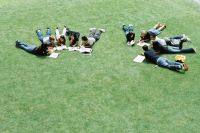|
 |
|
 |
| |
| |
| |
| |
| |
| |
| |
Campus: Kensington Campus
| |
| |
Career: Undergraduate
| |
| |
Units of Credit: 6
| |
| |
| |
| |
Indicative Contact Hours per Week: 3
| |
| |
Enrolment Requirements:
| |
| |
Excluded: MUSC1001, MUSI1141, MUSI1241, MUSI1003
| |
| |
| |
| |
| |
 |
|
 |
Description
Designed as an introduction to a wide range of musical styles, techniques and circumstances as well as methods of study in music. Enables students to acquire insight into compositional processes and the place music occupies in different societies. Includes study of early 20th century music and ethnomusicology.
Assumed knowledge: A satisfactory standard in HSC music or in AMEB 7th grade practical (pass) plus 5th grade theory or musicianship.
Learning Outcomes
On competing this course students should acquire:
- An understanding of the major trends in twentieth century musical and compositional thinking
- An outline knowledge of major musical figures and works of the period
- A socio-political and artistic contextualisation of such trends and figures
- Analytical tools necessary to support argument in musicological essays, as well as to enhance musical performance
- Knowledge about the manner in which both the practice of ethnomusicology and the history of European and European derived concert music in the first part of the twentieth century pose questions about music, aesthetics, the philosophy of art, and the social responsibilities of musicians
- An understanding of how writing and learning music history are processes of selectivity, and that the reasons for 'leaving things out', or giving them lesser emphasis, are themselves a historical subject
- A critical overview of historical and contemporary approaches to ethnomusicology
- A practical and critical overview of ethnomusicological techniques
- Bias-aware strategies for listening to and appraising music of varying degrees of familiarity
- An awareness of theories of musical meaning.
Assessment
- Essay - 40%
- Exam - 15%
- Tutorial, including short written assignments - 25%
- Music literature - 20%
|



